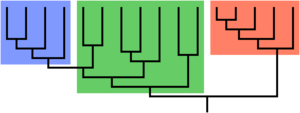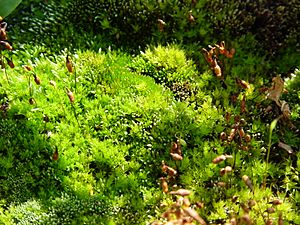Evolutionary grade facts for kids

An evolutionary grade is a group of living things that are at a similar level of development or organization. These groups share many similarities in how they look and how their bodies work. They are often adapted to live in the same way.
However, an evolutionary grade is different from a clade. A clade is a group that includes a common ancestor and all of its descendants. An evolutionary grade, on the other hand, groups species based on their shared traits or lifestyle, even if they don't all come from a single, unique ancestor in the same way a clade does.
The idea of an 'evolutionary grade' was first suggested by Julian Huxley. He used it to show the difference from a 'clade', which is a group based strictly on shared ancestry. Another famous biologist, Ernst Mayr, also supported using the term 'grade' in biology.
What is an Evolutionary Grade?
An evolutionary grade is a group of species that are similar in many ways. These similarities led people to give them a common name. However, for a group to be a true clade, it must include all descendants from a single common ancestor. This means the group must go all the way back to its very first known member.
A good example is the group we call reptiles. Many years ago, scientists divided four-legged animals (called tetrapods) into four main groups: amphibians, reptiles, birds, and mammals. In this old system, reptiles were defined by traits like laying cleidoic eggs (eggs with a shell), having skin covered in scales, and being 'cold-blooded'.
But now we know that early amphibians gave rise to the first egg-laying animals called amniotes. These amniotes then split into two main branches. One branch led to sauropsids (which include reptiles and birds). The other branch led to synapsids (which include mammals). So, the word 'reptile' today mostly refers to those sauropsids that are not birds. While 'reptile' is a common word everyone understands, it's not a perfect scientific term for a true clade anymore.
Groups that are paraphyletic or polyphyletic often represent evolutionary grades. A paraphyletic group includes a common ancestor but not all of its descendants. A polyphyletic group includes members from different ancestors. Sometimes, paraphyletic groups are just "leftover" groups that don't fit neatly into other clades.
Examples of Evolutionary Grades

- Bryophytes: For a long time, bryophytes (like mosses, liverworts, and hornworts) were thought to be a single natural group. They were defined as land plants that did not have vascular systems (like tubes for water). However, modern studies show that mosses, liverworts, and hornworts are actually separate groups. Mosses are even more closely related to vascular plants than the others. Still, all three groups have a similar level of complexity. So, the "bryophyte grade" is still useful for studying early plants and fossils.
- Fish: The group we call fish is another example of an evolutionary grade. This is because fish gave rise to the land vertebrates (animals with four limbs). The three main traditional groups of fish (Agnatha, Chondrichthyes, and Osteichthyes) are all evolutionary grades themselves. People will still use the word "fish" every day, but scientifically, it's important to remember they don't form a single, complete clade.
- Dinosaurs: If you include birds with dinosaurs, then they form a proper monophyletic group (a clade). But if you talk about "dinosaurs" without including birds, then they are not a true clade.
- Labyrinthodonts: These were early amphibians. The term "Labyrinthodont" is no longer used in modern classification because they represent an evolutionary grade, not a clade.
- Synapsids: The group called synapsids cannot be a clade unless mammals are included. Mammals evolved from synapsids.
- Nautiloids: Nautiloids are considered a paraphyletic group. They share older, basic features that are not found in more advanced cephalopods (like squids and octopuses). In other words, nautiloids are an evolutionary grade that is believed to have led to both ammonoids and coleoids.
Images for kids
-
The genus Australopithecus is an ancestor of Homo (humans). It is still an important group studied in palaeoanthropology.
See also
 In Spanish: Grado (cladística) para niños
In Spanish: Grado (cladística) para niños


